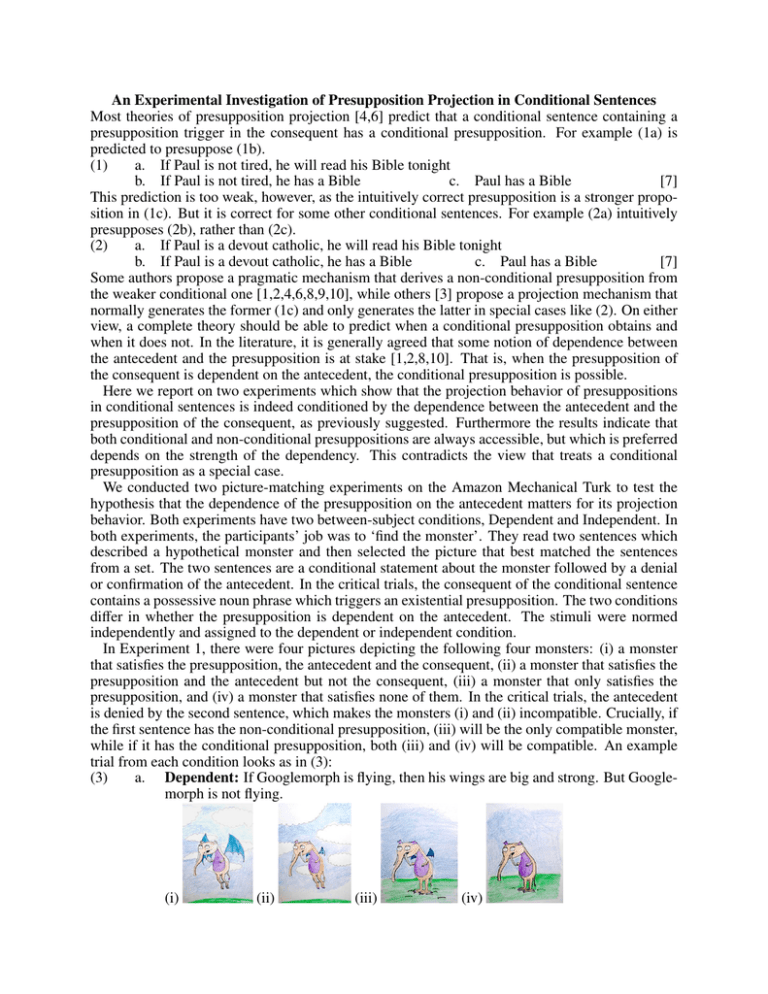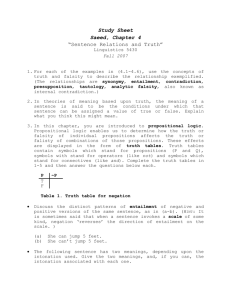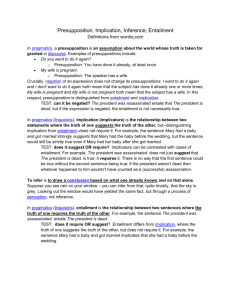An Experimental Investigation of Presupposition Projection in Conditional Sentences
advertisement

An Experimental Investigation of Presupposition Projection in Conditional Sentences Most theories of presupposition projection [4,6] predict that a conditional sentence containing a presupposition trigger in the consequent has a conditional presupposition. For example (1a) is predicted to presuppose (1b). (1) a. If Paul is not tired, he will read his Bible tonight b. If Paul is not tired, he has a Bible c. Paul has a Bible [7] This prediction is too weak, however, as the intuitively correct presupposition is a stronger proposition in (1c). But it is correct for some other conditional sentences. For example (2a) intuitively presupposes (2b), rather than (2c). (2) a. If Paul is a devout catholic, he will read his Bible tonight b. If Paul is a devout catholic, he has a Bible c. Paul has a Bible [7] Some authors propose a pragmatic mechanism that derives a non-conditional presupposition from the weaker conditional one [1,2,4,6,8,9,10], while others [3] propose a projection mechanism that normally generates the former (1c) and only generates the latter in special cases like (2). On either view, a complete theory should be able to predict when a conditional presupposition obtains and when it does not. In the literature, it is generally agreed that some notion of dependence between the antecedent and the presupposition is at stake [1,2,8,10]. That is, when the presupposition of the consequent is dependent on the antecedent, the conditional presupposition is possible. Here we report on two experiments which show that the projection behavior of presuppositions in conditional sentences is indeed conditioned by the dependence between the antecedent and the presupposition of the consequent, as previously suggested. Furthermore the results indicate that both conditional and non-conditional presuppositions are always accessible, but which is preferred depends on the strength of the dependency. This contradicts the view that treats a conditional presupposition as a special case. We conducted two picture-matching experiments on the Amazon Mechanical Turk to test the hypothesis that the dependence of the presupposition on the antecedent matters for its projection behavior. Both experiments have two between-subject conditions, Dependent and Independent. In both experiments, the participants’ job was to ‘find the monster’. They read two sentences which described a hypothetical monster and then selected the picture that best matched the sentences from a set. The two sentences are a conditional statement about the monster followed by a denial or confirmation of the antecedent. In the critical trials, the consequent of the conditional sentence contains a possessive noun phrase which triggers an existential presupposition. The two conditions differ in whether the presupposition is dependent on the antecedent. The stimuli were normed independently and assigned to the dependent or independent condition. In Experiment 1, there were four pictures depicting the following four monsters: (i) a monster that satisfies the presupposition, the antecedent and the consequent, (ii) a monster that satisfies the presupposition and the antecedent but not the consequent, (iii) a monster that only satisfies the presupposition, and (iv) a monster that satisfies none of them. In the critical trials, the antecedent is denied by the second sentence, which makes the monsters (i) and (ii) incompatible. Crucially, if the first sentence has the non-conditional presupposition, (iii) will be the only compatible monster, while if it has the conditional presupposition, both (iii) and (iv) will be compatible. An example trial from each condition looks as in (3): (3) a. Dependent: If Googlemorph is flying, then his wings are big and strong. But Googlemorph is not flying. (i) (ii) (iii) (iv) b. Independent: If Googlemorph is drinking orange juice, then his wings are big and strong. But Googlemorph is not drinking orange juice. (i) (ii) (iii) (iv) 133 native speakers of English participated in this study (67 in Dependent; 66 in Independent). Each of them saw four critical trials and twelve control trials. The results indicate that (iv) is chosen more often in Dependent than in Independent condition (M=36.6% vs. M=19.1%; Z=3.46, p< .001), as expected under our hypothesis. However it is also observed that in both conditions (iii) is chosen more often than (iv) (Dependent: W=266.5, p<.001; Independent: W=57.5, p<.001). This suggests that in both cases the conditional presupposition was dispreferred. One limitation of Experiment 1 is that the conditional presupposition is in principle compatible with both (iii) and (iv), which makes it unclear which presupposition the subjects obtained when they chose (iii). To determine whether participants could generate the conditional presupposition, when the possibility of the non-conditional presupposition was not clearly apparent, we conducted a second experiment. Experiment 2 is just like Experiment 1 except that it employs the covered box method ([5,7]) where one of the four pictures is hidden in a gray box. The participants were told to choose the covered box only if none of the other pictures matched the two sentences. Crucially, in the critical trials, (iii) is covered so that it is chosen only if the subjects get the non-conditional presupposition. 127 native speakers of English participated in Experiment 2 (62 in Dependent; 65 in Independent). Once again we found that the conditional choice (iv) was more common in Dependent condition (M=87.4% vs. M=77.8%; Z=2.32, p<.05), supporting the original hypothesis. However, unlike in Experiment 1, participants selected (iv) far more often than the covered box in both conditions, indicating that the conditional presupposition was available even in Independent condition (Dependent: W=1548, p<.001; Independent: W=1212.5, p<.001). Critically, participants selected the covered box consistently in control conditions (Dependent: M=97.6%; Independent: M=95.4%). The results of Experiment 2 are in line with a view in which both conditional and non-conditional presuppositions are accessed and later evaluated by a pragmatic mechanism, but not with a view in which the dependency is required to obtain the conditional presupposition. Specifically, the setting of Experiment 2, forced the participants to choose (iv) even in Independent condition, indicating the conditional presupposition was accessible. This implies that both presuppositions are always available even without the dependency, contrary to what a theory like [3] predicts. References: [1] Beaver, D. (2001) Presupposition and Assertion in Dynamic Semantics. [2] von Fintel, K. (2008) What is presupposition accommodation, again? Phil. Persp., 22. [3] Geurts, B. (1999) Presuppositions and Pronouns. [4] Heim, I. (1983) On the projection problem for presuppositions. WCCFL 2. [5] Huang, Y., J. Snedeker. & E. Spelke. (ms.) What exactly do numbers mean? [6] Karttunen, L. & Peters, S. (1979) Conventional implicature. Syntax and Semantics 11. [7] Pearson, H., M. Khan & J. Snedeker. (2010) Even more evidence for the emptiness of plurality. SALT 20. [9] Perez-Carballo, A. (2009) Toward a dissolution of the proviso problem. In Presuppositions and Implicatures. [9] Singh, R. (2008) Modularity and Locality in Interpretation. Ph.D. dissertation, MIT. [10] van Rooij, R. (2007) Strengthening conditional presuppositions. JoS, 24.




